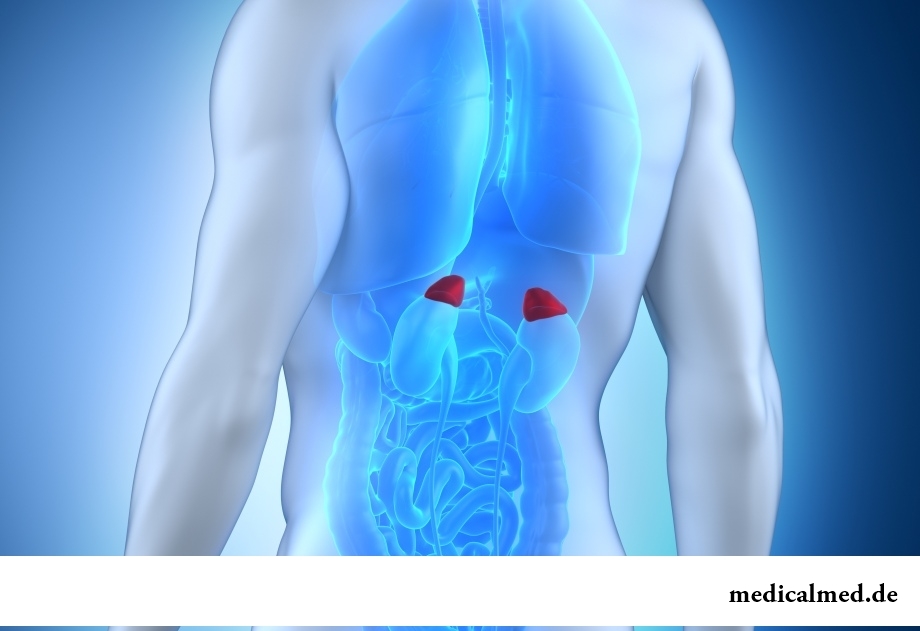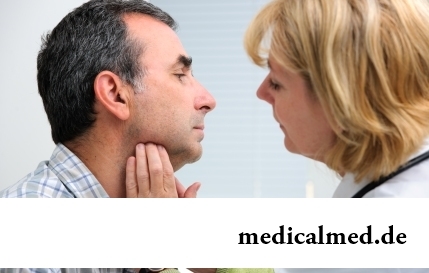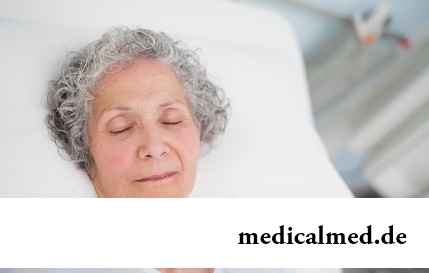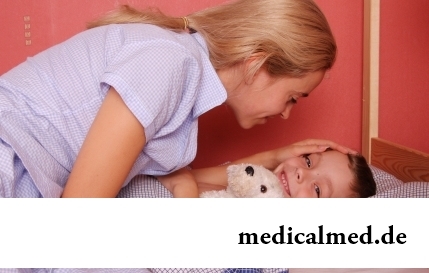





Adrenal glands
Adrenal glands (epinephral, adrenal glands) – the pair closed glands located over kidneys.

Structure and functions of adrenal glands
The structure of glands emits outside cortical substance and internal brain. They have a different origin, but in the course of historical development combined in one body. Adrenal glands have the different form – right triangular, and left semi-lunar. Outside of gland are covered with the capsule which gives shoots inside.
Cortical substance prevails, and makes about 9/10 from the mass of glands. It consists of the cells cosecreting corticosteroid and sex hormones. Cells are located rather circulatory capillaries so that the secret came to blood at once. In cortical substance of adrenal glands allocate three zones differing on cellular structure:
- Glomerular (develops Aldosteronum);
- Puchkovy (develops cortisol, corticosterone);
- Mesh (synthesizes androgens).
It is difficult to revaluate a role of corticosteroid hormones in an organism. They participate in the key moments of regulation of a metabolism (proteins, fats, carbohydrates, water and salts), energy, in a host defense of an organism, regulation of a tone of vessels, adaptation to stresses.
Marrow in the center of an adrenal gland is unsharply delimited from cortical, and consists of chromaffin cells, and also a set of nerve fibrils and cells. Secretory chromaffin cells synthesize adrenaline, dopamine and noradrenaline. On a chemical structure they concern group of catecholamines, and are initially formed of tyrosine amino acid. Emission of catecholamines in blood is stimulated with various irritants – emotions, a hypoglycemia, overcooling, physical activity, etc.
Adrenaline increases in blood glucose level due to disintegration of a glycogen, strengthens disintegration of fats with energy release, increases arterial pressure, strengthens the frequency and force of cordial reductions, weakens unstriated muscles in walls of bronchial tubes, strengthens formation of heat in an organism.
Noradrenaline – the predecessor of adrenaline, has a bit different effects – it urezhat cordial reductions, expands the arteries feeding with blood heart, increases diastolic pressure.
Research of functions of adrenal glands
It is impossible to probe adrenal glands at a palpatorny research. Ultrasonography allows to visualize them and to determine the sizes.
Function them is studied, investigating the level of hormones and their metabolites in blood. So that to estimate glucocorticoid function of adrenal glands, in blood determine the level 11 of oxycorticosteroids, and in urine – free cortisol.
Functional trials allow to estimate the response of adrenal glands to stimulation from the outside. Most often apply test with dexamethasone which helps to otdifferentsirovat a tumor of adrenal glands from the hyperplasia connected with excess synthesis of AKTG in a hypophysis. Test with AKTG allows to reveal functional insufficiency of adrenal glands, but in view of potential health hazard such tests should be carried out in a hospital.
Mineralokortikoidny function of adrenal glands and formation of hormone of Aldosteronum can be estimated on the maintenance of potassium ions and sodium in blood serum. At insufficiency of adrenal glands the content of sodium is considerably reduced, and potassium is increased, at excess formation of Aldosteronum of potassium on the contrary will be less, and it is more sodium.
Radiological methods of inspection of adrenal glands – a computer and magnetic and resonant tomography, an angiography. They allow to reveal tumors of adrenal glands, to estimate the sizes and structure of glands.
Diseases and approaches to treatment of adrenal glands
All diseases of adrenal glands can be divided into two big groups – one of them is shown by excess function of adrenal glands, and the second – on the contrary, reduced.
Decrease in work of glands happens during removal of adrenal glands, defeat by their tuberculosis, an amyloidosis, a sarcoidosis, at hemorrhage in adrenal glands or at decrease in formation of AKTG in a hypophysis. Treatment of adrenal glands in this case demands replacement therapy by those hormones which lack was created, and also elimination of the reason of hypofunction.
Excess formation of hormones meets at a hyperplasia from excess stimulation of AKTG (for example, at a hypophysis tumor) or at an adrenal gland tumor. Tumors from cortical substance – kortikosteroma – are more often mixed, at them there is an excess formation of all adrenal hormones. If the tumor comes from the cells forming androgens it call an androsteroma. The virilny syndrome will be its manifestation. If the cells forming Aldosteronum underwent tumoral transformation, then the aldosteroma forms, and the expressed disturbances of exchange of water and salts will become its manifestation.
At Itsenko-Cushing's disease sensitivity of a hypothalamus to the inhibiting influence of cortisol is broken, as a result adrenal glands strenuously develop it and hypertrophy. At such patients carbohydrate metabolism is broken, sexual function is reduced. Outward – adiposities in a stomach, a trunk and a neck, red-violet extensions on skin – striya, a crescent-shaped face, excess pilosis is characteristic. Treatment of an Icenco-Cushing syndrome consists adrenal glands and lifelong replacement hormonal therapy at a distance.
At high-quality regeneration of cells of marrow of adrenal glands the course of a tumor asymptomatic, and it becomes more often an accidental find at a research. Malignant hormonal and active tumors are shown by symptoms of hyperproduction of hormones, hormonal and inactive the general intoxication and increase in a stomach accompanies.
Treatment of adrenal glands at tumoral defeat surgical, at malignant tumors has to be followed by chemotherapy. After removal of adrenal glands lifelong replacement therapy is required by hormones.
Inborn dysfunction of bark of adrenal glands, Itsenko-Cushing's disease, hypoaldosteronism, hromaffinoma, addisonova a disease occur at children. Quite often they have a hemorrhage in adrenal glands, for example, at a severe birth trauma, serious infections (a spotted fever, etc.).
The person accepting antidepressants in most cases will have a depression again. If the person coped with depression by own efforts, he has every chance forever to forget about this state.

The endocrine system carries out in a human body extremely important role, practically all processes of life activity регулируютс...
Section: Articles about health
Within several decades of our compatriots convinced that the use of butter nasty affects a condition of coronary vessels. As a result the reputation of a product was impaired thoroughly a little, and many almost ceased to include...
Section: Articles about health
The person, as well as all other beings living on our planet feels weather changing. It is the normal meteosensitivity which is not causing to healthy people of special troubles. Meteodependence, on the contrary, is the morbid condition which is characterized by an exacerbation of chronic illnesses at change of air temperature, differences of atmospheric pressure, wind strengthening, magnetic storms and other "surprises" on which the nature is so generous. The people suffering from meteodependence have to з...
Section: Articles about health
There is an opinion that at low temperatures safety of products is ensured longer and better thanks to what the refrigerator considers...
Section: Articles about health
Some people consider what for medicine of the 21st century of secrets in the field of health of the person almost does not exist. It absolutely not so. The more answers scientists receive, the more the most difficult questions are raised for them by life. Besides, there are diseases, not объясн in any way...
Section: Articles about health
Neurosis is called pathology of a nervous system at which deviations in functioning of the highest nervous processes are observed. Most often - owing to yet not strengthened mentality - children are subject to neurosises. The unhealthy, hostile atmosphere in collective, a family, the strong and sharp shock, and also a set of other factors which negatively influence the little person who did not learn to overcome stresses yet can become premises to emergence of such disturbances....
Section: Articles about health
According to data of World Health Organization, the cataract is diagnosed almost for 7% of the population of Earth. Statistics we get sick...
Section: Articles about health
On health of the person physicians know about salutary action of animals long ago. About 7 thousand years ago great Hippocrates recommended to the patients riding walks for strengthening of a nervous system and increase in vitality....
Section: Articles about health
During foot walks blood moves on vessels more actively and one and all bodies are supplied with a large amount of oxygen. It affects the state of health of the person very positively....
Section: Slideshow
Separate food - the system of meal based on digestion physiology which is carried to improvement methods. In opinion д...
Section: Articles about health
Coffee - the tonic loved by many for the invigorating aroma and deep taste. Having the stimulating effect, coffee increases working capacity, promotes concentration of attention, fights against drowsiness and improves mood. Statistically, about 30% of inhabitants...
Section: Articles about health
Not without reason doctors say that 90% of diseases begin or develop because of misoperation of intestines. Disturbance of its functions is connected with various factors among which the important place belongs to excessive "clutter" of an intestinal path. In an organism not only the remains of food, but also mass of harmful substances which we with food accepted accumulate. Accepted to accept, and about that to remove them, did not take care. And in it a problem....
Section: Articles about health
The dietology, as well as other sciences, does not stand still. Food stuffs are exposed to comprehensive study, and scientists receive new and...
Section: Articles about health
For the last decades the diabetes mellitus of the second type became really world problem. The number of cases annually increases, and average age of patients for whom the illness is diagnosed, steadily decreases. Specialists consider that one of osno...
Section: Articles about health
The summer of this year in Russia was very ambiguous. Regions suffered from a merciless heat, from pouring rains, the hail from time to time dropped out, then there was again a heat which alternated with rainfall again. Many people suffer from such sharp changes of weather. Even flu epidemics and a SARS were recorded....
Section: Articles about health
The fatigue, sleep debt, disturbances of food, bad mood, vagaries of the weather – all these circumstances badly are reflected in our vn...
Section: Articles about health
Run - one of the most available and effective ways to revitalize the organism. Knowing about its extraordinary advantage, each of us at least once tried to make jogs, but only the few made these occupations regular. In spite of the fact that in jogging (easy an ozdor...
Section: Articles about health
Many parents of children at the age of 2-4 years face excessively whimsical behavior of the child. The kid exhausts constant crying and whims not only the parents, but also himself. In what the reasons of children's whims. And how to fight with them?...
Section: Slideshow
The concept "gluten" (differently, a gluten) combines group of the proteins which are a part of rye, barley and wheat. For most of people упот...
Section: Articles about health
Popular joke that there are no healthy people, and is nedoobsledovanny, most of us considers an honest truth, continually it is necessary to hear that all of us are sick hardly from a school bench. It is hard to say, whether so it actually because...
Section: Articles about health
The thought that the mass of their body is too big at least once in life visits from 80 to 95% of women. Many women are so obsessed with this idea that constantly try all new and new ways of weight reduction. A considerable part of these techniques is ineffective, and some in general are unsafe for health....
Section: Articles about health
For anybody not a secret that the modern person eats not as his ancestors. For the last 100 years in broad access appeared with...
Section: Articles about health
Life expectancy in various regions of Earth is not identical. Social stability, economic wellbeing, availability and level of medical care, household comfort, literacy of the population in the field of observance sanitary гигиен exert impact on it...
Section: Articles about health
Summer in the heat. Many are going to spend vacation abroad. Travelers the tender seas, rest on beaches wait, for sightseeing, campaigns on natural and cultural reserves. But, unfortunately, on vacation also problems with health can wait for us. On a foreign trip it is possible to face also diseases which not only will spoil long-awaited issue, but also will force to be treated within long months after its termination. To be insured completely from troubles of it a sort...
Section: Articles about health
Contrary to popular belief, the multiple sclerosis (MS) is not connected neither with sclerous changes of walls of vessels, nor about age...
Section: Articles about health
To look healthy and means well-groomed not only to be pleasant to people around, but also to feel strong, sure and taken place. Specialists in the field of cosmetology quite often note that whether not all women are able to look after skin...
Section: Articles about health
Visit of doctors – business not the most pleasant, and many people do not hurry to undergo necessary planned inspections. Such behavior is extremely thoughtless and improvident. Our health is necessary not only to us: wellbeing of darlings, children, grandsons and aged parents directly depends on as far as we are vigorous and able-bodied. Therefore in time to be inspected – a duty of any modern person. Specialists consider that 7 regular surveys and di are especially necessary for women...
Section: Articles about health
